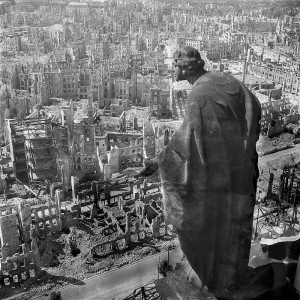The Bombing of Dresden city in Germany took place in the final months of the Second World War.
In four raids between 13 and 15 February 1945, 722 heavy bombers of the RAF and 527 of the USAAF dropped over 3,900 tons of high-explosive bombs and incendiary devices on the city. The bombing and the resulting firestorm destroyed 8 square miles of the city centre. It is estimated between 22,700 and 25,000 people were killed.
Three more USAAF air raids followed, two occurring on 2 March and 17 April aimed at the city’s railroad marshaling yard and one small raid on 17 April aimed at industrial areas. Post-war discussion of whether or not the attacks were justified has led to the bombing becoming a moral controversy of the war.
A 1953 Unit ed States Air Force report defended the operation as the justified bombing of a military and industrial target,
ed States Air Force report defended the operation as the justified bombing of a military and industrial target,
which was a major rail transport and communication centre, housing 110 factories and 50,000 workers in support of the German war effort. Several researchers have claimed that not all of the communications infrastructure, such as the bridges, were targeted, nor were the extensive industrial areas outside the city centre.
Critics of the bombing argue that Dresden was a cultural landmark of little or no military significance,
and that the attacks were indiscriminate area bombing and not proportionate to the commensurate military gains
Large variations in the claimed death toll have fueled the controversy.
In March 1945, the German government ordered its press to publish a falsified casualty figure of 200,000 for the Dresden raids, and death toll estimates as high as 500,000 have been given. Although Dresden authorities at the time estimated no more than 25,000 victims, a figure which subsequent investigations as recently as 2010 support.
